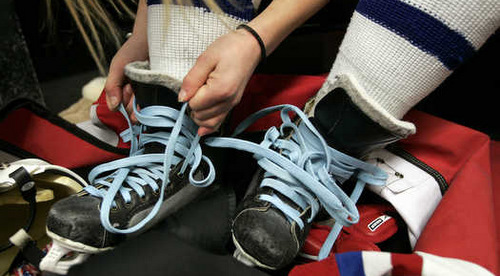
Hockey skate trend increases injury, study suggests
Hockey is a dangerous game. Players are stronger and faster than they have ever been. On-ice collisions are vicious and inflict major damage. Thankfully, innovations in hockey equipment are helping keep players safer and able to play the game longer. However, certain advancements in equipment technology are actually causing harm to the players that lace up their ice hockey skates.
After 21 years in the NHL, Claude Lemieux has seen his fair share of injuries but, now a chairman on the board of directors with GRAF Skates, he’s warning people of the alarming increase in foot injuries caused by modern skates and has teamed up with researchers from Brock University in Ontario to improve the skate industry.
“There’s an epidemic of bone spurs and lace bites,” said the four-time Stanley Cup winner in an interview with The Good Point last month.
Troy Crowder of GRAF Skates, who is helping Lemieux design customizable alternatives, said “the evolution of skates has been to become stiffer and lighter, but that introduces a whole group of problems where the skates don’t flex anymore, where [players] are getting lace bites and their feet are hurting.”
Lace bites are an inflammation of the foot’s exterior tendons, which in hockey are caused by the boot or skate laces continually rubbing the tendons on the top of the foot or ankle bones. These can sometimes get so painful that players have trouble tying their skates.
Bone spurs are tiny bone outgrowths from joints, which can limit joint movement and cause sharp pain.
Due to these foot injuries, “we’re seeing guys have to take 2-3 days off the ice,” said Lemieux. “[Players are] wearing ice packs on their feet after every single practice because they have so much pain.”
[php snippet=1]
Many players try to avoid this pain by adding a gel pad inside their skates, but this can actually cause increased movement within the skate and limit the amount a player can bend, making them worse skaters.
When Lemieux was in the NHL, players with these type of problems believed they stemmed from skating 2-3 hours every day. But now the same problems are happening to children who only play a few times a week.
Lemieux himself never suffered foot problems, attributing this to always wearing a traditional, soft leather skate, which provides extra flexibility, although many former teammates did suffer from these painful injuries.
“I’ve been around locker rooms at the NHL level and just looking at [players’] feet I can tell who is having problems,” Lemieux said. “The one’s [having the problems are] wearing the really, really stiff skates … Joe Thornton’s wearing a very traditional, older model skate, not very stiff, and it reflects on his feet. He’s got no problems.”
The link between newer skate models and these injuries seems clear, although evidence is needed to prove it. That’s where researchers at Brock University stepp in.
Kelly Lockwood, an associate professor in the Kinesiology department at Brock, is beginning a nationally-funded project in collaboration with GRAF Skates, testing the role skates play in on-ice performance with a long-term goal of examining the link between foot injuries and skate design.
Participants are players that span all levels of hockey, including young children in house leagues, members of the Brock varsity team, players from the OHL’s Niagara IceDogs and even older adults playing in recreational leagues. The study will also look at referees and coaches to better understand how skate design impacts everyone on the ice.
Participants will go through three tests on the ice. First, participants will be run through a battery of on-ice drills in their original skates. Next, with the help of GRAF skates, a custom boot will be designed for each individual and they’ll go through the same set of drills with their new skates. Finally, in the third and most important stage, more forward flexion will be added to the custom boot and participants will once again go through the same battery of drills.
By comparing performance at each level, researchers hope to prove that the design of the skate, specifically its flexibility, does indeed influence performance.
“Often people are happy with what they have until you show [them] something better,” Lockwood said. “People often don’t realize their current skates are actually harming their performance until they try something that fits much better.”
Although the current research does not directly test the relationship between skate design and the development of bone spurs and lace bites, it is believed that better fitting, more flexible skates will prevent these injuries. The current study is the first step in proving that and researchers are seeking additional funding from agencies like NSERC to continue their work.
Lemiuex summarizes the goal of the research best. “We’re here to better the quality of the product and help the players.”
This collaboration has the ability to revolutionize the skate industry, and a better fitting skate means better skating, which ultimately means better hockey.
[php snippet=1]

